$590.00 – $690.00Price range: $590.00 through $690.00
The vertical grid test is similar to the horizontal grid test first described by Kim et al (2010) to assess motor function. The apparatus is a vertically positioned grid box mounted with acrylic, and this allows the mouse to grab on the grids as it climbs down. The MazeEngineers vertical grid apparatus allows simple motor assessment, is lightweight, and available for mice and rats. Multiple colors available.

MazeEngineers empowers preclinical neuroscience research with meticulously designed, customizable behavioral apparatuses. From manual classic mazes to fully automated smart systems, we provide the tools scientists need to capture high-quality, reproducible data for studies on learning, memory, anxiety, and depression.
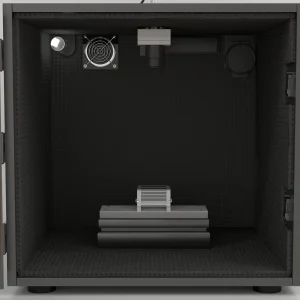
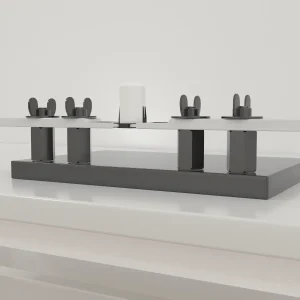
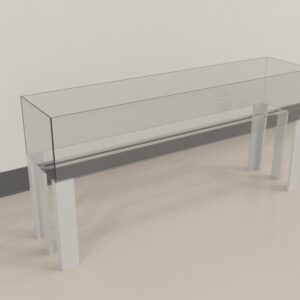
Mouse |
Total Size: 8 cm×55 cm× 5 cm (L x W x H) |
Wire Mesh: 0.8cm x 0.8cm |
Open front; 4 sides of black acrylic. Bottom with 5cm foot for stability |
Rat |
Total Size: 12 cm×85 cm× 8 cm (L x W x H) |
Wire Mesh: 0.1cm x 1cm |
Open front; 4 sides of black acrylic. Bottom with 7.5cm foot for stability |

The Vertical Grid is a new variation of the Horizontal Grid test developed by Kim et al. in 2010. Like the Horizontal Grid test and Gait test, the Vertical Grid is useful for assessing motor impairments and evaluating the impact of pharmacological treatments. By merging the benefits of both the Horizontal Grid test and the Pole test into a single device, the Vertical Grid provides enhanced stability compared to the Horizontal Ladder test. The horizontal ladder’s start and goal boxes often fail to provide optimal balance, making the Vertical Grid a promising alternative.
Animal models of diseases such as Parkinson’s and Huntington’s are invaluable for studying disease-related motor dysfunctions. These models are essential for understanding how muscles interact with other body systems and for assessing the effectiveness of various treatments.
The Vertical Grid apparatus consists of an open box having dimensions 8 x 55 x 5 cm. A wire mesh of 0.8 x 0.8 cm grid openings is set on the back of the box, while the front is open. The sides of the apparatus are made of black Plexiglas. An extension of 5 cm at the bottom of the apparatus provides stability.
The Vertical Grid apparatus is thoroughly cleaned both before and after each experiment to ensure accuracy and hygiene. The setup is well-illuminated, and automated tracking and recording systems, such as Noldus Ethovision XT, are available to facilitate data collection and analysis.
In the standard procedure, the subject is positioned 3 cm from the top of the grid, facing upwards. The subject is then given the opportunity to turn around and descend the grid. If the subject does not manage to climb down within 60 seconds, the trial is repeated. To prepare for the test, subjects undergo acclimation sessions on the Vertical Grid three times a day for two days prior to the experiment.
To evaluate the effects of 1-methyl-4-phenyl-1,2,3,6-tetrahydropyridine (MPTP), subjects receive an intraperitoneal injection of 20 mg/kg MPTP dissolved in saline at 2-hour intervals, administered four times. After a period of six days, subjects are tested on the Vertical Grid to evaluate motor deficits, following the methodology outlined by Kim et al. (2010).
The following data is collected during the Vertical Grid test.
The following sample graph compares the total number of successful hindlimb steps of controls, and MPTP treated subjects on the Vertical Grid test.
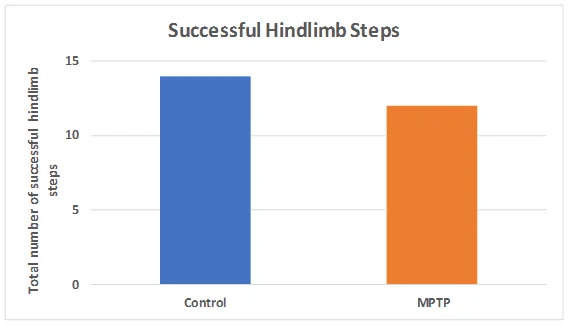
The following sample graph compares the total number of successful hindlimb steps of controls, and MPTP treated subjects on the Vertical Grid test.
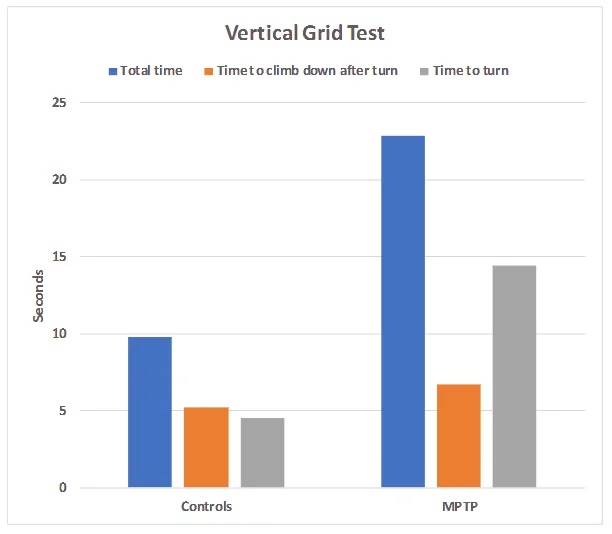
The Vertical Grid test integrates the benefits of both the horizontal grid test and the pole test, offering a valuable tool for assessing muscular dysfunction and evaluating the impact of medications. Additionally, it can be applied to study age-related neuromuscular decline and to investigate nerve regeneration and damage. The apparatus is straightforward to operate and is designed to be lightweight.
Featuring a compact design, the Vertical Grid ensures superior stability compared to the Horizontal Ladder test. The start and goal boxes that support the ladder rung of the horizontal ladder often fail to provide adequate balance. Thus, the Vertical Grid test serves as an effective alternative to the commonly used Horizontal Ladder test.
Repeated testing on the Vertical Grid may lead to muscle fatigue in subjects. Additionally, the performance of the subjects can be influenced by their weight, so having a large group of subjects with similar weights is crucial for obtaining consistent results. It is essential to incorporate rest periods between trials to prevent fatigue from skewing the data. Other factors such as age and sex may also impact performance, and these variables should be considered when evaluating results.
Kim ST, Son HJ, Choi JH, Ji IJ, Hwang O (2010). Vertical grid test and modified horizontal grid test are sensitive methods for evaluating motor dysfunctions in the MPTP mouse model of Parkinson’s disease. Brain Res. 1306:176-83. doi: 10.1016/j.brainres.2009.09.103.
| Species | Mouse, Rat |
|---|
There are no questions yet. Be the first to ask a question about this product.